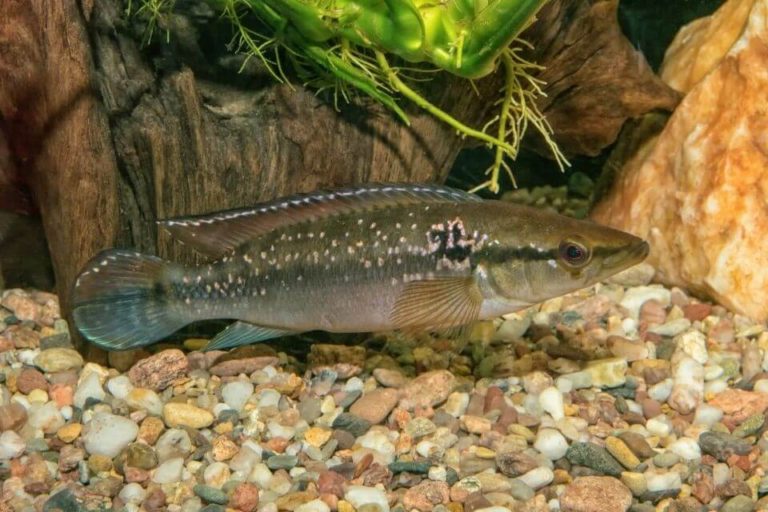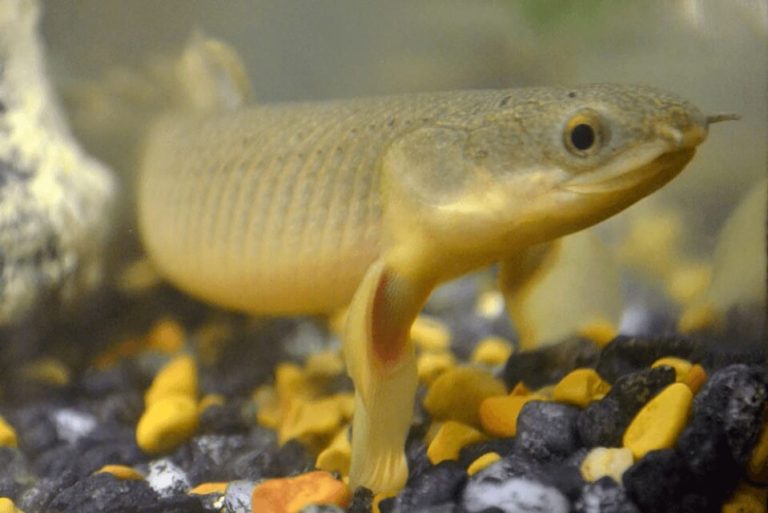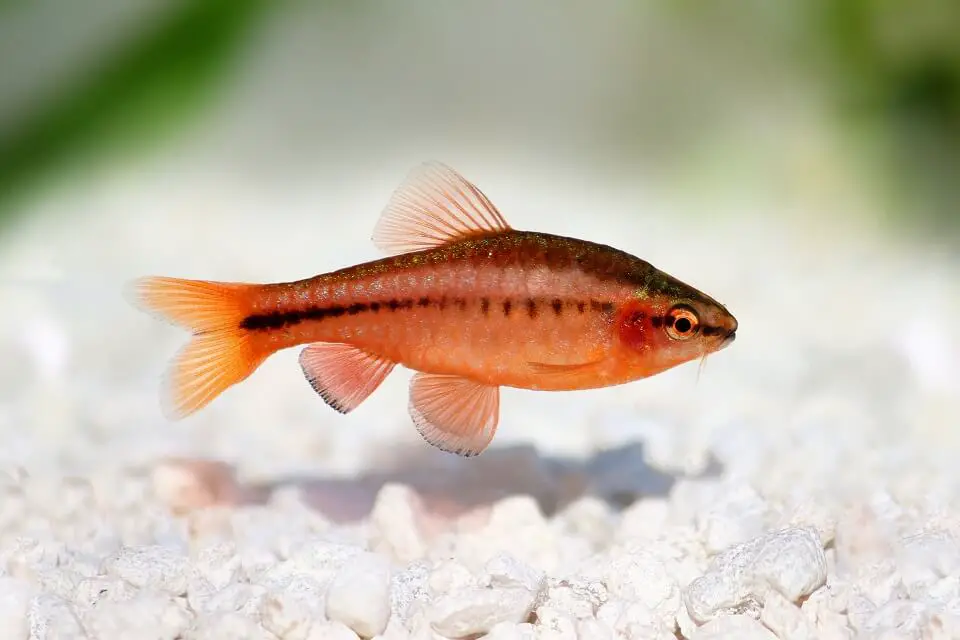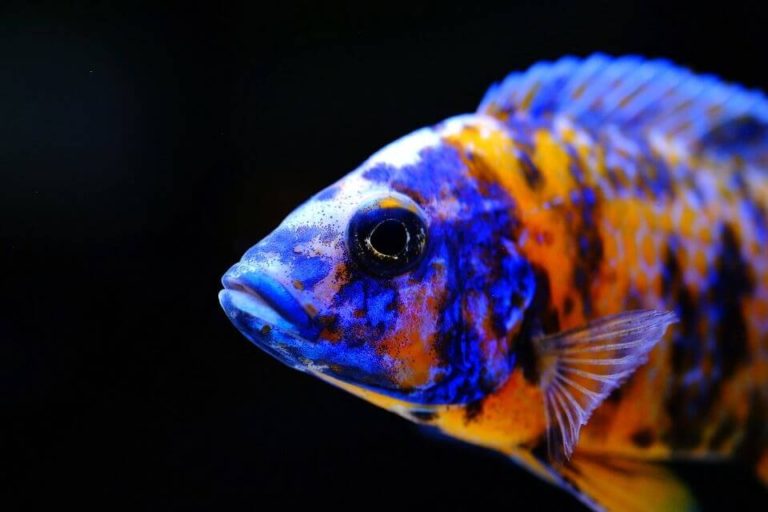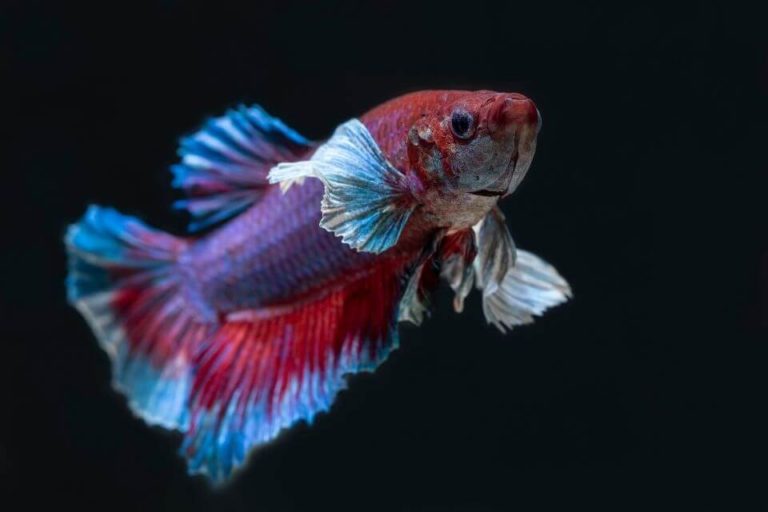Bloodfin Tetra Care Guide: Tank Setup, Tank Mates, Feeding and Breeding

A Bloodfin Tetra is a visually appealing freshwater fish that’s easy to care for and a fantastic pet fish. Known as one of the peaceful Tetra breeds and is an amazing addition to a community aquarium or a home fish tank.
This fish species bring to a tank vibrancy due to their bold silver body and contrasting red fins. They’re even more interesting when it comes to their hardy characteristic. Bloodfin Tetra is known to survive in cold tanks, something that’s quite atypical for freshwater tank fish. Slight water conditions are also not a major concern for this fish.
This guide is a rundown of the Bloodfin Tetra care and conditions aimed to educate anyone looking to keep this fish in their aquarium. We’ll explore various details about the fish, including its behavior, tank care, and conditions, breeding, tank mates, etc.
| Quick Facts: | |
|---|---|
| Common Names : | Bloodfin Tetra |
| Origin : | Warm water bodies in South America |
| Family : | Characidae |
| Scientific Name : | Aphyocharax anisitsi |
| Care Level : | Easy |
| Temperament : | Peaceful |
| Social : | Schooling fish |
| Diet : | Omnivores |
| Size (average) : | Upto 2 inches |
| Lifespan : | 5 - 8 years |
| Breeding : | Egg layer |
| Minimum Tank Size: | 20 gallons |
| Tank Environment : | Freshwater Sand substrate Driftwood, rocks Live aquarium plants |
| Temperature : | 71 – 82 °F (21 – 27 °C) |
| Water Hardness : | 3 - 12 dGH |
| Water pH Level : | 6.0 - 8.0 |
Overview of Bloodfin Tetra
Scientific name: Aphyocharax anisitsi
This fish is an adorable freshwater fish of the Characidae family. It traces back to the rivers and basins of South America. This fish is a colorful species that shares many characteristics of typical Tetras. No matter the size of your tank, the Bloodfin Tetra will always attract most of the attention.
From their bold primary silver color to the vivid red on their fins, the Bloodfin Tetras win it all when it comes to appearance. They also boast a torpedo-shaped body with a larger head and midsection.
The average Bloodfin Tetra size of a mature fish is 2 inches. These fish generally live for 5 to 8 years. Note that you have to provide everything they require, from a high-quality diet to proper tank conditions, for them to reach their maximum potential and live healthily and happily for their lifespan.
It is peaceful and does well when kept in large groups. The fish is generally hardy and easy to care for but sensitive to poor water conditions. Some hobbyists even keep the fish in cold tanks under certain conditions.
Since these fish are omnivorous, it’s not hard to find the perfect food for them. High-quality dry pellets should form their main food, while high-protein foods such as bloodworm and shrimp can be used as treats.
Bloodfin Tetra breeding is straightforward when it is done in a separate tank. The breeding tank should be planted appropriately and all conditions such as water hardness and temperature set as needed to initiate breeding. A female Bloodfin Tetra produces 300 to 500 eggs per round, meaning that you’ll always have this fish all year round.
Origin, Distribution, and Availability
They are endemic to the warm water bodies in South America. High populations are found in the Parana River basin. This river runs through Brazil, Paraguay, and Argentina. There’re also traces of these fish species in Colombia, Peru, and throughout the Amazon.
The water from these habitats is shaded by an overhead canopy and other vegetation. The habitat is also generally murky due to the decomposing plant matter.
Due to their unmatched appearance and behavior, Bloodfin Tetras are well distributed in areas with tropical climates. This fish is commercially bred in mass and readily available in the freshwater markets globally.
The average price for a single Bloodfin Tetra for sale is $2 to $3 in your local pet stores. Online aquarium pet sellers may carry Bloodfin Tetra for sale as well.
Bloodfin Tetra Behavior
These fish species are generally peaceful and calm, making them a perfect community fish. They rarely disturb their tank mates unless there’re viable reasons. The fish can fight among themselves, but this is not a cause of concern, provided it’s not a constant behavior and coming from different-sized fish.
Keeping large Bloodfin Tetras with tiny ones is definitely not recommendable. Larger Bloodfin Tetras are fond of picking and nipping at the smaller fish, especially during feeding. If this is a constant behavior, you need to separate the individuals that make the others uncomfortable.
Sometimes the nipping behavior can be extended to other fish species, but again, this will happen when there’s a considerable size difference. The fish is also attracted to the flowing fins of fish such as Guppies and Bettas. These should never be suitable tank mates.
They are excellent and fast swimmers. They will spend most of their daytime swimming and moving around the tank.
They’re also schooling fish, so if you’re in for a show from your tank, you should keep them in large groups. 5 to 7 individuals is a perfect number for a group of these pretty fish. The fish will mostly be found in the upper half of the tank.
This fish can jump above the water surface, especially when breeding. For this reason, you need to ensure that their tank is properly secured with a lid.
Appearance, Colors, and Special Markings

The Bloodfin Tetra is one of the most visually appealing Tetras you’ll keep in your freshwater tank. Despite being a small fish, the body takes an unmatched torpedo-like shape with a heavier head and mid-section.
The primary body color of this fish is silver. What makes this fish more attractive is the iridescent finish that sits majestically on the magnificent silver color. In a well-lit tank, it looks like there’re greenish-blue flashes from the fish’s body. These light bounces make even the plainest tank into a lively and charming one.
The charm does not end at the iridescent finish-the fins of this fish are unmatched too. Even with their small size, they boast a sizeable caudal fin that perfectly contrasts the rest of the body.
Their dorsal, anal, and tail fins are covered by a vivid red color that is the best contrast for the silver primary color. Although the Bloodfin Tetra is a ray-finned fish, this feature is not vivid as in other Tetra species. It’s, however, quite striking to see that the fin tips are transparent.
Bloodfin Tetra Size
The Bloodfin Tetra is not a sizeable fish and will only grow up to 2 inches in length when mature. Impressively, their small size translates to manageable tank size requirements as they can survive in pretty small tanks.
A Bloodfin Tetra born in poor conditions will always have stunted growth and will barely get to this average size.
Bloodfin Tetra Lifespan
Like most Tetras, the lifespan of a Bloodfin Tetra is 5 to 8 years. This lifespan can only be achieved if you keep the fish in a well-maintained tank and with proper feeding. If the fish is subjected to stressful conditions, chances of contracting diseases are increased and in turn, the lifespan is shortened significantly.
Aquarium Care and Conditions
– Tank Conditions and Care
Setting a Bloodfin Tetra tank is pretty simple as no special conditions or equipment are needed. For the equipment, your standard filter will work for this fish. Just ensure that it cycles the water properly at all times.
The fish can survive in water that stays over room temperature all year through. If this is the case in your area, there’s no need to invest in a heater. What’s more, with proper lighting, the water temperature can be altered to match what the fish requires.
– Bloodfin Tetra Tank Size
The minimum tank size requirement for this fish is 20 gallons. This tank is perfect for 5 to 7 fish that is the recommended number of individuals for a single group of this fish.
You can have a larger tank to give these fish even more room to roam and cleaner conditions due to improved dilution. A sizeable tank is also appropriate for keeping a larger school or various fish species with the Bloodfin Tetras.
– Tank Setup
When it comes to the tank set up for Bloodfin Tetra, you need to replicate most of what their natural habitats offer.
Starting with the tank’s bottom, a dark sandy substrate is a perfect simulation of the river beds that form their natural habitats. The dark substrate will contrast perfectly what the fish offers in terms of radiant appearance- this, of course, being supported by perfect tank lighting.
Talking of lighting, they require 10 to 12 hours of medium-light every day. The intensity of the light can, however, be varied to match the tank’s size and the amount of substrate/ decorations added to the tank.
In terms of decorations, you need to maximize natural vegetation. You can still add plastic caves, rocks, and driftwood. You can also place these decorations at the tank’s bottom, where the fish doesn’t occupy most of the time.

– Suitable Plants
The South American rivers that the Bloodfin Tetra comes from are loaded with vegetation, so adding natural vegetation to the tank would perfect for this fish. Floating Plants and tall plants are superb for them.
Amazon Sword, broadleaf Anubias, narrow leaf Anacharis, Java Moss, and Java Fern are some of the recommended and suitable plants.
As you add the plants to the tank, capitalize on the perimeters so that you don’t take up much of the fish’s swimming space. Let the size of the school you’ve kept guide you when evaluating the space you should leave in the center of the tank.
Plants offer Bloodfin Tetra shelter or places to hide when they’re frightened. Additionally, the plants block very bright light from getting into the tank.
– Water Conditions and Parameters
These fish species are not so demanding when it comes to specific water conditions and parameters. These fish can survive in a vast range of water conditions, not to mention that they can thrive in environments with slight changes.
The fish prefers warm water but can also survive in cold tanks as long as the pH is neutral. These are the general water conditions for the Bloodfin Tetra:
- Water temperature: 64 – 82 °F (17 – 27 °C)
- Water pH: 6.0 – 8.0
- Hardness: 3 – 12 dGH
Frequent water testing is crucial as it ensures that these conditions are kept at their required level at all times. Water changes weekly or after two weeks would also aid in keeping the water conditions in check. By keeping the conditions in the required range, you’ll have eliminated most of the diseases that may affect this fish.
Note that all these conditions are a simulation of this fish’s natural habitat and make the most comfortable environment for this fish.
Diet and Feeding For Bloodfin Tetra
Bloodfin Tetras are thankfully omnivores, so finding food that they’ll enjoy is pretty straightforward. High-quality dry food such as pellets and flakes should form the primary diet for this fish.
To supplement the dry foods, you can occasionally give the fish high protein treats such as bloodworms, brine shrimp, and daphnia.
Feeding these fish two times a day is most appropriate. For the amount, keep it small or at least what they can finish in a few minutes. Overfeeding is a health risk for a Bloodfin Tetra due to its small size. Food leftovers can also deteriorate the tank’s conditions making it hard for the fish to thrive.
Bloodfin Tetra Diseases
Unless the water conditions have significantly deteriorated, the Bloodfin Tetra will thrive and stay healthy at all times. Despite their small size, they’re pretty hardy and adapted to survive in various tank conditions.
A high amount of Ammonia and extreme changes in the water temperature can affect the fish’s health and wellbeing. In such conditions, the fish will be stressed and get exposed to common fish conditions (fungal, bacterial, and parasitic conditions).
One disease that can toll on the fish is ich. This skin infection will occur when the water condition is exceedingly poor. Luckily the condition can be reversed with over-the-counter medications. On the other end, overlooking it can turn out to be fatal.
How Can You Tell If A Bloodfin Tetra Is Male Or Female?
There are not too many features to sex this fish, but it’s not entirely impossible to tell a male from a female. The males are generally more vibrant than the females. If you have a sharp eye, you will notice that the males have more prominent green-blue flashes and more vivid reds on their fins.
During breeding, the females tend to be rounder and plumper than the males. Males grow smaller hooks on the pelvic and anal fins compared to females.
Bloodfin Tetra Breeding
Bloodfin Tetra breeding is somewhat easy. You just need to set up a separate breeding tank with good plant coverage. To initiate breeding, capitalize on protein-rich foods as the primary food for this fish and reduce the lighting levels. Softer water is also recommended for breeding.
On successful mating, the female will lay 300 to 500 eggs and let them sink to the bottom by jumping above the water surface. If in the mood, the female can lay the eggs on wide leaf plants.
The eggs hatch after a couple of days, after which the fry survive on their yolk sacs. You can feed the fry with infusoria until they’re ready to eat high-quality, nutrient-rich baby shrimp.
Parenting is not a thing for this fish, so you should remove the adult fish from the breeding tank after successful spawning. They may snack on the eggs if they’re left in the breeding tank. When the small fish are good enough to hold up on their own, you can transfer them to a regular display tank.

Bloodfin Tetra Tank Mates
Bloodfin Tetras are schooling fish, so they mainly enjoy their own company. A school for this fish species is generally made up of 5 to 7 individuals. In case you have an extensive tank, a larger school would work just fine. It’ll make the fish feel more secure and comfortable living in the tank.
Bloodfin Tetra tank mates are not limited to their own company. The fish is compatible with other fish species of similar size.
Here are perfect tank mates for this fish:
Other kinds of Tetras
- Cory Catfish
- Neon Tetra
- Cardinal Tetra
- Ember Tetra
Tetras form the major section of Bloodfin Tetra tank mates because they depict almost similar behaviors
- Ghost and Amano shrimp (gentle Shrimp)
- Bristlenose or Rubber Lip Plecos (peaceful Plecos)
- Pictus Catfish and Bumblebee Catfish (bottom-dwelling catfish)
Note that this list contains just a section of the plenty of fish species that the Bloodfin Tetra can live with. You can evaluate any other fish that matches the behaviors of the ones listed above to know if it’s a compatible Bloodfin Tetra tank mate.
Always keep in mind that the Bloodfin Tetra is a small fish that can be a target for larger and highly aggressive fish.
Frequently Asked Questions
– Can Bloodfin Tetras Live Alone?
It’s not recommended to keep a single Bloodfin Tetra in a tank. The fish is generally social and a schooling species; thus, keeping them this way can be stressful and uncomfortable. The minimum number that’s recommended to keep this fish is 5. A single group can, however, extend up to 7 mature individuals.
The number of groups you can keep in a single tank depends on its size. You should do your evaluation on the basis of 20 gallons for a 5 to 7 Bloodfin Tetras group.
– Are Bloodfin Tetras Hardy?
Bloodfin Tetras are superbly hardy. They’ll thrive in a wide range of tank conditions- even cold tanks! Slight water conditions are also not a major concern to this fish’s wellbeing. Even with all this resistance, the Bloodfin Tetra is still sensitive to high levels of ammonia and extreme temperatures.
With poor conditions, you may have to deal with diseases such as ich which the Bloodfin Tetra is highly prone to.
– Do Bloodfin Tetras Need A Heater?
The need for a heater depends on the general climate of the area where they’re kept. In areas where the water temperature can be maintained above room temperature, a heater is not necessary. However, if the temperatures are extremely low in your area, their tank needs a heater to keep the temperature stable.
Additionally, with proper lighting (10-12 hours a day), the temperature will remain stable and in a range that the fish will feel comfortable.
– Are Bloodfin Tetras Aggressive?
Bloodfin Tetras are not labeled as aggressive but friendly and peaceful. However, they can be troublesome when kept in stressful conditions and with smaller fish. If they are kept with completely docile fish, they may outcompete them for food.
To maintain Bloodfin Tetra good behaviors, provide ample swimming space, good water conditions, proper diet, and most importantly, keep them with peaceful and similar sized tank mates.
– Are Bloodfin Tetras Fin Nippers?
Bloodfin Tetras can be fin nippers if there’re certain supporting conditions. The leading cause of fin nipping in Bloodfin Tetra is keeping them with smaller fish, regardless of whether they’re their own companion or other fish species. There’re always lured into fin nipping and picking at their smaller counterparts when competing for food.
Bloodfin Tetra can also exhibit fin nipping when kept with fish with flowing fins such as Bettas and Guppies. These should never be kept with Bloodfin Tetras, even if they are compatible in other aspects such as behavior.
– How Many Bloodfin Tetras Can I Put In A 10 Gallon Tank?
A 10 gallons tank can only accommodate 3 to 4 Bloodfin Tetras, which is below the recommended minimum number of a single group which is 5. Although keeping 3 to 4 fish in a single tank won’t affect their wellbeing significantly, the fish are less likely to clock their full potential.
A 10 gallons tank is, however, perfect for fry that has just been transferred from their breeding tank. In such a case, it’s even okay to keep 10 Bloodfin Tetras in the 10 gallons tank.
Final Thoughts
There’re so many Tetras that you can keep in your tank, but the Bloodfin Tetra stands out for being pretty, easy to care for, and most importantly, well-behaved. Their heightened activity brings life to absolutely any tank- whether a Tetras tank or a community tank.
Keeping a solo fish in a tank can’t work for this fish species as they like schooling. Acquire at least 5 individuals if you want to keep Bloodfin Tetras happy and stress-free. Thanks to its excellent tolerance, the Bloodfin Tetra is more than perfect for a beginner.
The Bloodfin Tetra is definitely not the first Tetra you’ll consider adding to your freshwater fish, but it’s worth every bit of the brilliant investment. You got all the crucial details you require for this magnificent fish, so acquire it today and join the team of delighted Bloodfin Tetra owners!


